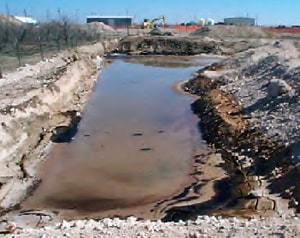
Chesapeake Herradura No. 3 Unlined, Earthen Workover Pit that contaminated ground water. Located in Lea County. (Courtesy photo)
The Gulf oil disaster puts a new spin on Ben Franklin’s old adage, “An ounce of prevention is worth a pound of cure.” In the case of BP’s Deepwater Horizon well it appears that some relatively small environmental safety measures upfront could have helped prevent or at least ameliorate the millions of gallons of oil that now foul the Gulf of Mexico from Louisiana to Florida.
In New Mexico we know that it is always less expensive to prevent pollution from occurring than it is to clean it up after the fact. That is part of the reason that our Oil Conservation Commission adopted an ounce of prevention in the form of new environmental rules in June 2008, to prevent contamination generated by the oil and gas industry from polluting our water supplies.
Our efforts are working. Since the adoption of this new precautionary rule, commonly known as the Pit Rule, there has not been a single reported case of groundwater contamination caused by a drilling pit. However, some in the oil and gas industry have criticized the cost of these environmental regulations.
The Pit Rule is about properly managing contaminated oil and gas waste to protect New Mexico’s precious groundwater – the primary drinking water source for 90 percent of New Mexicans. These rules do cost money to implement, but the costs are far less than what companies (such as BP in the Gulf) would have to pay to clean up spills.
When you get the oil changed in your vehicle, whether you do it yourself or take it to a shop, the used oil should be carefully drained, managed, and containerized. Whether it’s a do-it-yourself or professional oil change, you don’t just dig a hole in the ground, pour it in and bury it and walk away. There are rules governing disposal of this waste to make sure that the groundwater we all share is protected. The Pit Rule is no different.

Jon Goldstein
New Mexico is leading the way
One of industry’s claims is that the rule is not based on sound science. Contrary to this claim, the state conducted a scientific pit sampling project in 2007 in which each sample was split and shared with industry for the Pit Rule hearing. Documentation of the test results conducted by both parties showed the presence of dozens of contaminants in pit contents, including heavy metals, chlorides, and hydrocarbons. The public is invited to review the state’s scientific findings by clicking here.
The Pit Rule was created in a constructive, coordinated, and completely public process with the input of industry, the environmental community, and many other stakeholders, including a 23-day public hearing and public comment, which generated nearly 14,000 pages of transcript.

Prior to the Pit Rule, the state documented 800 cases of groundwater contamination that were self-reported by the oil and gas industry – 421 of those cases were caused by waste-pits. The Pit Rule is designed to prevent any future groundwater contamination by all types of oilfield pits and also to protect operators from the potentially crippling liability of major environmental impacts like BP faces in the Gulf.
In fact, Interior Secretary Ken Salazar has followed New Mexico’s lead and announced that the Department of the Interior’s Bureau of Land Management is reforming its oil and gas program to improve environmental protection of important natural resources on U.S. public lands while aiding in orderly land leasing and the balanced development of the nation’s energy supply.
Local Bureau of Land Management staff recently stated that new federal guidelines will not significantly impact local producers in New Mexico because of the Pit Rule and some of the other more progressive measures the state has already taken to protect groundwater. New Mexico may become one of the only places in the west where industry will be able to drill while the other states play catch-up with new federal regulations.
Not driving business away
The industry has also claimed that the Pit Rule has driven business out of the state. The fact is that production of oil and gas and rig counts in New Mexico experienced the same highs and lows as in neighboring states, all of which correlate to the price of the resource. And drilling activity in New Mexico has actually increased significantly this year according to the Baker Hughes rig count, with 68 operating rigs reported on July 9 of this year compared to 38 operating rigs a year ago on July 10, 2009.
Apache Corporation is an independent energy company that explores for, develops and produces natural gas, crude oil and natural gas liquids. It recently announced that it expects to drill in excess of 200 new wells during 2010. Of the 200-plus wells expected to be drilled, 100 new wells will be drilled in New Mexico, representing the most wells drilled by Apache Corporation in the state in any year.
The price of oil and gas fluctuates, but companies are finding and producing oil and gas more efficiently and in an environmentally friendly manner using new technologies contemplated by the Pit Rule, such as directional drilling, utilizing existing well pads for new wells, and using closed loop systems to manage their waste.
Good environmental regulations protect our water while wise land use decisions protect our pristine areas for generations to come. These decisions will always come with some degree of controversy but history will show them to have been the wise and diligent course. It is better to have prevented catastrophe through diligence than to foolishly cross our fingers and hope for the best. After all, as Ben Franklin also said, “Diligence is the mother of good luck.”
Goldstein is cabinet secretary for the state’s Energy, Minerals and Natural Resources Department. This article has been updated to include today’s rig count.